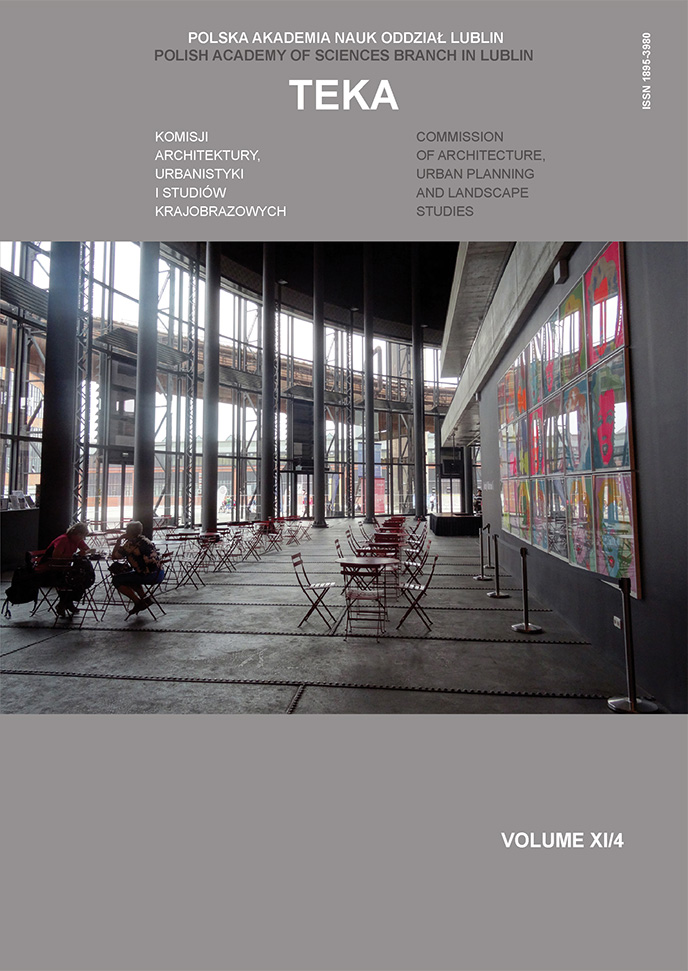Methods of creating temporary public spaces
Article Sidebar
Open full text
Issue Vol. 11 No. 4 (2015)
-
The perception of sacrum in modern architecture
Michał Dmitruk7-14
-
The housing industry in didactics
Agnieszka Kłopotowska, Maciej Kłopotowski15-23
-
Advertisement in art, art in advertisement in context of public space
Agnieszka Chęć-Małyszek24-33
-
Physical space of school – contemporary design indeas
Wojciech Kocki, Jacek Bogucki, Bartłomiej Kwiatkowski34-41
-
Quiet rooms – contemporary design trends
Bartłomiej Kwiatkowski42-48
-
Improving energy performance of a housing estate: assessment of actions taken so far in precast concrete panel blocks of flats
Anna Ostańska, Katarzyna Taracha49-59
-
Library as the heart of a school. The project of Phillips Exeter Academy Library, 1965−72
Marta Pieczara60-67
-
Placemaking de Louis I. Kahn
Marta Pieczara68-77
-
Architectural composition in didactics
Elżbieta Pytlarz78-86
-
Methods of conducting classes on town planning design for the students of architecture in the department of building and architecture at Lublin University of Technology
Marzena Joanna Siestrzewitowska87-99
-
Issues of relativism in the global architecture
Aleksander Serafin100-105
-
Four examples which represent two directions glimpses of polish architecture of the 21st century
Hubert Trammer106-116
-
Testing habitability for sustainable building design
Rolando-Arturo Cubillos-González117-125
-
Methods of creating temporary public spaces
Natalia Przesmycka126-143
Archives
-
Vol. 15 No. 4
2019-12-30 6
-
Vol. 15 No. 3
2019-10-31 9
-
Vol. 15 No. 2
2019-06-28 12
-
Vol. 15 No. 1
2019-03-29 13
-
Vol. 14 No. 3
2018-10-28 14
-
Vol. 14 No. 2
2018-06-29 14
-
Vol. 14 No. 1
2018-03-30 13
-
Vol. 13 No. 4
2017-12-29 8
-
Vol. 13 No. 3
2017-09-29 9
-
Vol. 13 No. 2
2017-06-30 10
-
Vol. 13 No. 1
2017-03-31 10
-
Vol. 12 No. 4
2016-12-30 12
-
Vol. 12 No. 3
2016-09-30 10
-
Vol. 12 No. 2
2016-06-30 9
-
Vol. 12 No. 1
2016-03-31 8
-
Vol. 11 No. 4
2015-12-30 14
-
Vol. 11 No. 3
2015-09-30 7
-
Vol. 11 No. 2
2015-06-30 8
-
Vol. 11 No. 1
2015-03-31 11
Main Article Content
DOI
Authors
Abstract
The use and creation of temporary public spaces becomes more and more popular, particularly occurring in large cities. This phenomenon remains somehow outside of the mainstream research interested in urban planning, however, it is one of the basic elements of modern urban policy. Temporary public realm can have various sources: lack of financial resources for development, a willingness to examine whether a type of function in a specific localization will work. Many public authorities today lack the financial means to resolve problems of public space. The social activities, not always lawful, resulting from the ongoing needs of the occupants or users, have very important impact on public space. Some temporary use projects show that many of them will become a professional business or may become a permanent function in the area. This paper presents some examples of temporary use or temporary creation of public spaces in chosen European cities.
Keywords:
References
Aguiar Rodrigues R., A Warning to Lisbon: The Fight for Meaning in Martim Moniz, http://www.failedarchitecture. com/a-warning-to-lisbon-the-fight-for-meaning-in-martim-moniz/
Cumberlidge C., Musgrave L., 2007, Design and Landscape for People. New Approaches to renewal. Thames&Hudson, London. DOI: https://doi.org/10.1353/cye.2007.0011
Dymna E., Rutkiewicz, M., 2012, Polskie street art, cz.2. Między anarchią a galerią, Carta Blanca, 2012.
Falkowska D., 2012, Zabawa na bulwarze, Architektura i Biznes, 9/2012.
Frąckiewicz S., 2015, Żeby było ładnie. Rozmowy o boomie i kryzysie street artu w Polsce, Poznań, Galeria Miejska Arsenał.
Gaventa S., 2006, New Public Spaces, p. 169, London, 2006.
Gehl J., 2004, Miasto dla ludzi. p. 145, RAM, Kraków.
Klanten R., Ehman S., Hübner MFeireiss., L. (ed.), 2012, Going Public. Public Architecture, Urbanism and Interven¬tions, Gestalten, Berlin.
Kuĉan A., 2009, Playscape-in defence of public space, [w: ]On Site. Landscape Architecture Europe, LAE Fundation Bassel. Boston Berlin.
Moor M., Rowland J., (red.), 2006, Urban Design Futures, Tylor&Francis Group.
Rykwerth J., 2013, Pokusa miejsca. Przeszłość i przyszłość miast. Międzynarodowe Centrum Kultury, Kraków, s. 25
Urban Pioneers, Berlin: stadtenentwicklung durch Zwischennutzung, Senatverwaltung fur Stadtenwicklung Berlin und Jovis Verlag GmbH, Berlin 2007
Van Uffelen Ch., 2010, Street Furniture, Braun
http://culture.pl/pl/tw (11/08/2015)
http://icd.uni-stuttgart.de/?p=12965 (06/08/2015)
http://refunc.nl/?p=1171 (06/08/2015) DOI: https://doi.org/10.4236/jmp.2015.68121
http://www.dac.dk/en/dac-life/copenhagen-x-gallery/cases/temporary-urban-spaces-at-carlsberg/
http://www.dezeen.com/2013/01/03/blue-plan-for-copenhagen-harbour-by-tredje-natur/ (07/08/2015)
http://www.empowerplaygrounds.org/ (06/08/2015)
http://www.fao.org/fileadmin/templates/FCIT/PDF/UPA_-WBpaper-Final_October_2008.pdf
http://www.targowek.info/2012/07/pomnik-palety-robi-sie-wiekszy/
http://wydzialsztuki.up.krakow.pl/?page_id=2809 (07/08/2015)
https://en.wikipedia.org/wiki/Roundabout_PlayPump (07/08/2015)
Article Details
Abstract views: 257


